-
Contenido
1.646 -
Registrado
-
Última Visita
-
Days Won
29
Mensajes publicados por manolojones
-
-
hace 40 minutos, Eriol24 dijo:PS, una pregunta...normalmente una nueva rama va acompaña de algún premium. Podemos esperar algo similar con la rama de cruceros españoles? No se si lo habrás comentado en algún directo o puesto por algún sitio.
También había pensado lo mismo.
En el caso de los panamericanos, pusieron de premium al Almirante Abreu, ¿no? Un equivalente español sería el Reina Regente.
1 -
-
hace 20 minutos, Davixu dijo:Entiendo que a partir de tier VII la rama española de cruceros, a parte del consumible de reparación, tiene el "Burst series" como el DD Álvaro de Bazan, no?
Sí, eso es.
0 -
A falta de características definitivas y vistas más detalladas, éstas son mis primeras impresiones sobre esta línea, centradas en consideraciones históricas y basadas en la documentación e información que reuní para elaborar esta Bola de Cristal.
Tier I a VI. Barcos históricos.
Poco que decir, salvo que el Méndez Núñez en tier II es un despropósito. No cuadra para nada con el tipo de buques empleados hasta ahora para ese tier, más propio de cruceros protegidos que de una reconstrucción realizada en los años 40, que dio como resultado un buque moderno y completamente distinto del original. Con una recarga más rápida, podría haber ido unos tier arriba, y haber sido nuestro mini-Atlanta.
También comentar, aunque sea solo a nivel estético, que al Baleares le sobran las banderas de neutralidad. Creo que todos sabemos que no vivió lo suficiente como para llevarlas. Hubiera quedado más propio haberlo presentado con el esquema de pintura que llevaba cuando lo hundieron.
Tier VII. Proyecto Ansaldo VIII - 203.
Lo primero que llama la atención, chirría más bien, son las torres de telemetría antiaérea alemanas. Éstas quedan de PM en un buque con arquitectura alemana, pero en este caso, son un pegote que afea las esbeltas líneas de los diseños italianos. Cierto es que España compró aparatos de telemetría a Alemania, pero dudo mucho que nuestros ingenieros navales no las hubieran adaptado al diseño italiano, o a uno propio, en vez de limitarse a copiar esas cúpulas alemanas.
La artillería antiaérea de origen alemán está perfectamente elegida, salvo por los montajes dobles de 105 mm. No están del todo mal, ya que sí que se intentaron adquirir, aunque la compra no se materializó, pero hubieran quedado más propios los montajes dobles de 120 mm DP de fabricación nacional, con los que se proyectaron los diseños de postguerra para cruceros y destructores. O incluso con los frustrados cañones de 90 mm de diseño propio. La artillería secundaria de 120 mm sería un toque característico de la línea española.
Un detallazo la catapulta de origen alemán, por lo que supongo llevará de dotación un He 114.
(Nota mental: hacer una versión del Littorio español con torres de telemetría estilo alemán y cañones de 105 mm…)
Tier VIII. Proyecto Ansaldo IX – 203.
El nombre… no sé yo… Si hacemos el ejercicio de ponernos con la mentalidad de la época, dado que Cataluña fue el último bastión del bando republicano durante la Guerra Civil, y que no aportó nada a la victoria final de Franco, parece poco probable que nombraran así a un buque de la Armada. De hecho, hasta la fragata F-73, ya en los años 70, no hubo ningún buque con ese nombre, y eso que dos de los barcos de la ayuda americana recibieron nombres de regiones, Castilla y Aragón. En dos ocasiones. Castilla es el tier X. Ahí lo dejo…
Las torres de telemetría antiaérea tienen la misma consideración que en el caso del Asturias.
La artillería antiaérea. Torres de 128 mm DP, las favoritas de @Criseox…
 Un poco pronto ese calibre para un tier VIII, me parece, aunque históricamente hablando, también se intentaron comprar a Alemania. Haría la misma consideración de antes con respecto a artillería de origen nacional. En cuanto al resto de antiaéreos, ¿en serio? ¿Antiaéreos italianos? ¿Qué parte del Programa Bär no ha entendido Wargaming? ¿No fueron ellos mismos los que pusieron antiaéreos alemanes en el Álvaro de Bazán, un tier X? Esta mezcolanza de antiaéreos es infumable. Estas armas deberían haber sido las mismas que en el Asturias. Si quieres, con los 37 mm buenos en vez de la chusta que compramos.
Un poco pronto ese calibre para un tier VIII, me parece, aunque históricamente hablando, también se intentaron comprar a Alemania. Haría la misma consideración de antes con respecto a artillería de origen nacional. En cuanto al resto de antiaéreos, ¿en serio? ¿Antiaéreos italianos? ¿Qué parte del Programa Bär no ha entendido Wargaming? ¿No fueron ellos mismos los que pusieron antiaéreos alemanes en el Álvaro de Bazán, un tier X? Esta mezcolanza de antiaéreos es infumable. Estas armas deberían haber sido las mismas que en el Asturias. Si quieres, con los 37 mm buenos en vez de la chusta que compramos.
También se ve catapulta alemana, por lo que también debería llevar un He 114. O ya puestos, un Ar 169.
Tier IX. Proyecto SECN 138.
Este buque no corresponde a ninguna de las tres configuraciones de artillería (4x3 203 mm, 2x3 280 mm y 2x2 305 mm) propuestas para este diseño. WG se ha sacado de la manga una cuarta configuración con un calibre que, a pesar de lo que afirma, nunca fue valorada para ningún proyecto de crucero español.
Puestos a usar un SECN, en este tier hubiera sido más realista la versión de 4x3 203 mm que propusimos.
En este caso, las cúpulas alemanas de telemetría hasta quedan bien; sí señor.
La artillería secundaria de 128 ya cuadraría más con el tier, pero sigo pensando que las torres de 120 mm darían un toque más distintivo. Además, a estas alturas ya podrían usarse las torres del Oquendo.
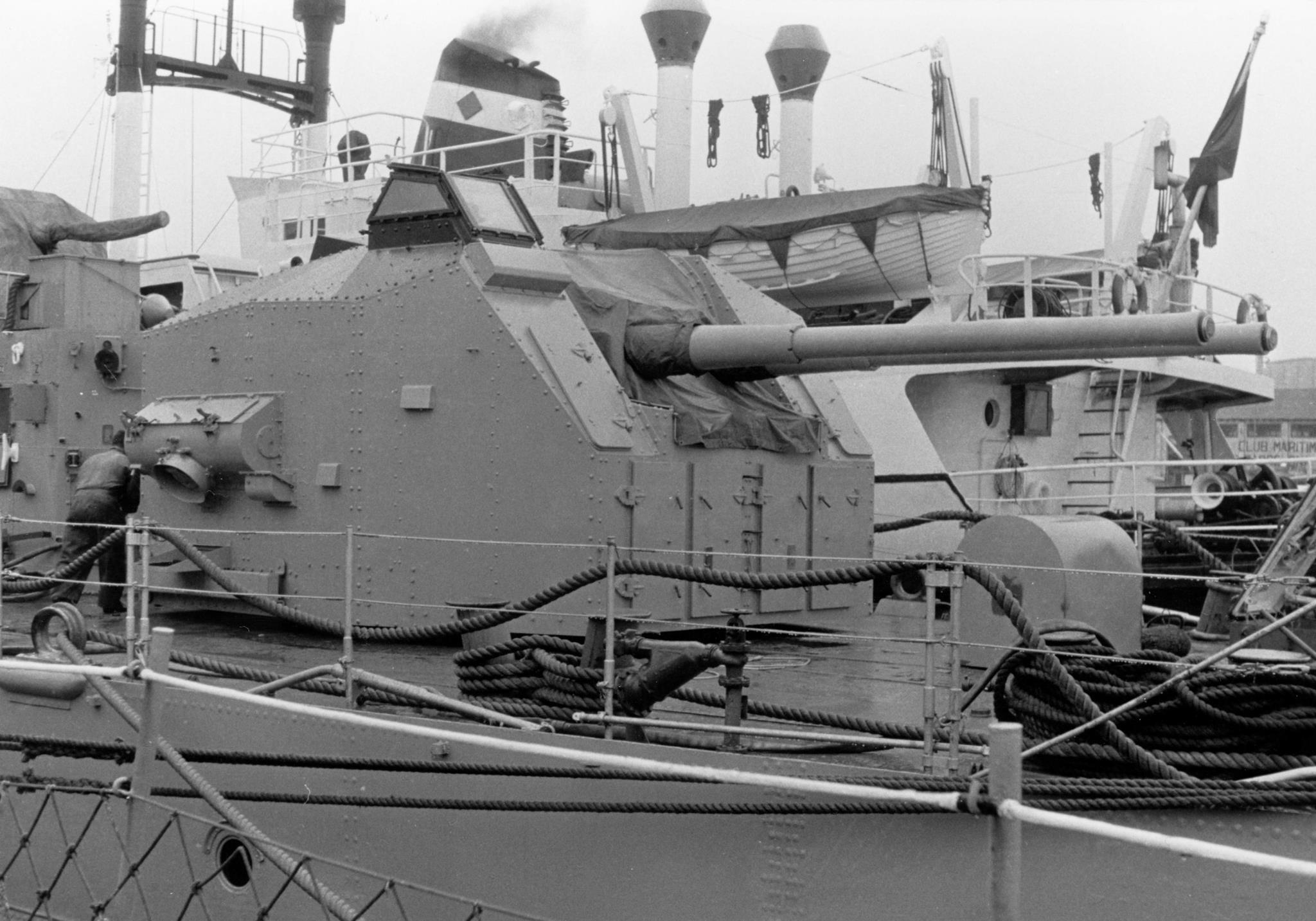
Estas torres tienen su encanto, aunque quien las diseñó, o era un genio o un desequilibrado. Vaya pesadilla geométrica…

Y más antiaéreos italianos… Me remito al comentario anterior. Personalmente, no habría descartado el uso de Bofors de 40 mm. A fin de cuentas, los proyectos que hubo, incluso los de destructores, contemplaban cañones de 40 mm, que solo podían ser los Bofors.
EDITO: me he dado cuenta de que los otros directores de tiro, junto con sus radiotelémetros, son británicos... Un poco improbable para esa época, ¿no?

Tier X. Invento de WG.
Este barco no corresponde a ningún proyecto real. Como mucho, es un pastiche, basado en un rediseño del gran crucero italiano tipo Napoli con elementos alemanes. Teniendo eso en cuenta, los cañones principales de 234 mm y la artillería secundaria de 128 mm, podrían ser hasta lógicos, pero seguimos con la incongruencia de los antiaéreos italianos. Si no se le ponen cañones Bofors y Oerlikon, lo suyo es que hubiera estado equipado con artillería de 30 mm y 55 mm alemana.
Habrá que estar atentos a todas las informaciones que vayan saliendo de esta línea.
EDITO 2: Cada vez estoy más convencido de que WG no se ha documentado muy bien, o está haciendo lo que le sale de las narices. En el video que ha salido se ven hidroaviones IMAM Ro.44, y la catapulta que parecía alemana es en realidad italiana. Sí que operamos este tipo de aviones, de los huidos a las Baleares cuando la rendición de Italia. Un avión de estos podría cuadrar en el tier VII, pero para los demás, España ya tenía un avión mejor, el Heinkel 114, que llegó a estar embarcado en el crucero Miguel de Cervantes. Para los tier IX y X el Ro. está más que obsoleto.
6 -
Ni en cooperativas te libras de ellos. Aunque ningún jugador los lleve, te pueden salir submarinos bots en ambos equipos.
0 -
hace 4 horas, B4karra dijo:No descartes un Canarias '53 en tier VII con torpedos y con F. Por supuesto premium
hace 1 hora, León Fandiño dijo:Bufff, de WG se puede esperar cualquier cosa visto lo visto en estos años!!!
Suelen sacar un premium coincidiendo con el evento de acceso anticipado, ¿no?
Aún nos podrían dar una sorpresa...
0 -
13.04.2023 20:00- DEVELOPMENT BLOG
NEW SHIPS - CLOSED TEST 12.4
A branch of Spanish cruisers has been added to the game for testing, as well as Dutch cruiser Van Speijk, German cruiser Schill, and Pan-Asian destroyer Lüshun.
For the upcoming closed testing session, a branch of Spanish cruisers will be added to the game.
Ships of this branch rely on main battery guns with good firing range. They are also armed with torpedoes, which have short range. The ships have good concealment but mediocre maneuverability.
Starting from Tier VII, the ships gain access to the "Burst Fire" alternative fire mode, which additionally increases AP shell penetration and damage. Main battery guns have flat ballistics, but low damage per minute. The ships also have high speed.
The new ships have a good choice of consumables:
- Hydroacoustic Search starting from Tier IV and the option to instead equip Defensive AA Fire in the same slot starting from Tier VI.
- Repair party and Fighter or Spotting aircraft in one slot starting from Tier VII
Spanish cruiser Jupiter, Tier I

In the 1930s, Spain began building a new class of minelayers, all named after Roman gods. Jupiter-class ships were also to serve as gunboats, for which they received effective gunnery. While still under construction, the lead ship of the Jupiter-class was captured by the Nationalists during the Spanish Civil War. After commissioning, the ship participated in the blockade of the Republican coast in the Bay of Biscay by intercepting transports and setting up minefields - the same minefields that caused the sinking of Nationalist battleship España in April 1937.
Spanish cruiser Méndez Núñez, Tier II

The ships Blas de Lezo and Méndez Núñez, based on the British C-class cruisers, were laid down in 1917. Since the first ship of the class couldn't be completed in time for the 100th birthday of its intended namesake Admiral Méndez Núñez in 1924, the names were switched around and Méndez Núñez became the name of the second ship of the class. With the outbreak of the civil war, the crew of the cruiser Méndez Núñez remained on the side of the Republicans. During the war, the cruiser escorted merchant ships and took part in the battle at Cape Palos. In 1938, Méndez Núñez was damaged by Nationalist bombers.
Spanish cruiser Navarra, Tier III

Named after the wife of the reigning king of Spain at the time, Victoria Eugenie of Battenberg, this ship was laid down in March 1915. The project was based on British cruiser Birmingham. In 1923–26 the ship took part in the Rif War, in 1928–29 she underwent a major overhaul, and in 1930 she was transferred to the naval school in Cadiz. With the proclamation of the Second Spanish Republic, the cruiser was renamed República. With the outbreak of the civil war, the ship went over to the side of the Nationalists and in 1937 changed its name again, this time to Navarra.
Spanish cruiser Almirante Cervera, Tier IV

In 1922, together with the British company Armstrong, a project was created for new cruisers for the Spanish fleet. The project was based on British E-class cruisers and took into account the experience of World War I. The Spanish cruisers differed from their prototype in the location of the power plant. At the beginning of the civil war, a fight took place on the cruiser Almirante Cervera: Republican loyalists tried to take the ship out of port, but were defeated by Nationalist officers. The cruiser took part in the blockade of the coast, supported the advance of the troops with fire, escorted convoys, and participated in the battle of Cape Palos.
Spanish cruiser Galicia, Tier V

The cruiser Príncipe Alfonso was renamed Libertad with the formation of the republic. With the outbreak of the civil war, the ship remained on the side of the Republic, although it was commanded by a cousin of Francisco Franco. At Cape Tenes, Libertad scored several hits on the Nationalist heavy cruiser Baleares, and at Cape Palos she engaged both enemy heavy cruisers. The ship was later damaged by several Italian air raids. When Libertad fell into the hands of the Francoist government, it received the name Galicia.
Spanish cruiser Baleares, Tier VI

In 1926, Spain ordered two modern "Washington Treaty" cruisers. Vickers-Armstrong created a project based on the County-class cruisers with increased air defense and armor. The cruisers were named Canarias and Baleares after the major Spanish archipelagos. The construction was delayed, but the Nationalists who seized the shipyards forced the completion of the cruisers. Beleares participated in the attack on Malaga, in the hunt for transports, raids on coastal fortifications, and the bombardment of cities. The cruiser was sunk by Republican destroyers at the Battle of Cape Palos.
Spanish cruiser Asturias, Tier VII

Ties between the government of fascist Italy and the Francoist regime strengthened after the latter claimed victory in the Spanish Civil War. These connections were also manifested in the field of naval construction: Spain planned to familiarize itself with the latest achievements in Italian shipbuilding in order to strengthen its fleet. The Italian company Ansaldo developed three projects for a heavy cruiser for Spain, which differed from each other in the composition of their armament. One of the options included an armament composed of four 203 mm twin-gun mounts.
Spanish cruiser Cataluña, Tier VIII

After the victory of the Nationalists in the civil war, ties between Spain and fascist Italy grew stronger. Suffering from an insufficient number of modern ships of all classes, Spain planned to familiarize itself with the latest achievements in Italian shipbuilding in order to strengthen its fleet. The Italian company Ansaldo developed three projects for a heavy cruiser for Spain, which differed from each other in the composition of their armament. Another one of the projects included an armament composed of three 203 mm triple-gun mounts.
Spanish cruiser Andalucía, Tier IX

In parallel with the work on the construction and repair of ships for the fleet, Francoist Spain was developing new ships. In 1938, five destroyer projects and several cruiser projects with a displacement of 7,920 to 19,000 tons were planned out. The largest was project 138 - "a cruiser with a speed of 36 knots" with different options for the main battery. The option of building a cruiser using the turrets from the battleship España was considered. The most common variant is the three triple-gun turrets with guns ranging in caliber from 203 to 254 mm.
Spanish cruiser Castilla, Tier X

Simultaneously with their own development of heavy cruisers, Spanish engineers were in close contact with their Italian colleagues and adopted from them the latest achievements in the field of armor and armament of ships. The knowledge gained could well result in a project created on the basis of a synthesis of Italian and Spanish naval thought - the projects of the Ansaldo cruisers and the project of the "super-Washington" cruiser from the Ferrol shipyard.
Ship's statsSpanish cruiser Jupiter, Tier I
Hit points – 7400. Plating - 6 mm. Fires duration: 30 s.
Main battery - 4x1 120 mm. Firing range - 9.1 km.
Maximum HE shell damage – 850. HE shell armor penetration - 20 mm. Chance to cause fire – 5%. HE initial velocity - 808 m/s.
Reload time - 4.5 s. 180 degree turn time - 18.0 s. Maximum dispersion - 83 m. Sigma – 2.00.
AA defense: 3x1 20.0 mm., 2x1 76.2 mm.
AA defense short-range: continuous damage per second - 32, hit probability - 85 %, action zone - 2.0 km;
AA defense mid-range: continuous damage per second - 11, hit probability - 90 %, action zone - 3.0 km;
Maximum speed - 18.5 kt. Turning circle radius - 340 m. Rudder shift time – 3.7 s. Surface detectability – 7.3 km. Air detectability – 5.1 km. Detectability after firing main guns in smoke – 2.7 km.
Available consumables:1 slot - Damage Control Party (Duration time 5 s; Reload time 25 s; Equipment is unlimited)
All stats are listed without crew and upgrade modifiers but with best available modules. The stats are subject to change during the testing.
Spanish cruiser Méndez Núñez, Tier II
Hit points – 20800. Plating - 6 mm. Fires duration: 30 s.
Main battery - 8x1 120 mm. Firing range - 11.8 km.
Maximum HE shell damage – 1700. HE shell armor penetration - 20 mm. Chance to cause fire – 8%. HE initial velocity - 808 m/s.
Maximum AP shell damage - 2050. AP initial velocity - 808 m/s.
Reload time - 10.0 s. 180 degree turn time - 18.0 s. Maximum dispersion - 115 m. Sigma – 2.00.
Torpedo tubes - 2x3 533 mm.
Maximum damage - 10433. Range - 4.0 km. Speed - 58 kt. Reload time - 72 s. Launcher 180 degree turn time – 7.2 s. Torpedo detectability - 1.1 km.
AA defense: 5x2 37.0 mm., 2x4 20.0 mm., 8x1 120.0 mm.
AA defense short-range: continuous damage per second - 39, hit probability - 85 %, action zone - 2.0 km;
AA defense mid-range: continuous damage per second - 25, hit probability - 90 %, action zone - 3.5 km;
AA defense long-range: continuous damage per second - 98, hit probability - 90 %, action zone - 5.2 km;
Number of explosions in a salvo - 1, damage within an explosion - 980, action zone 3.5 - 5.2 km.
Maximum speed - 29.0 kt. Turning circle radius - 530 m. Rudder shift time – 6.0 s. Surface detectability – 8.4 km. Air detectability – 5.8 km. Detectability after firing main guns in smoke – 3.2 km.Available consumables:
1 slot - Damage Control Party
All stats are listed without crew and upgrade modifiers but with best available modules. The stats are subject to change during the testing.
Spanish cruiser Navarra, Tier III
Hit points – 21200. Plating - 6 mm. Fires duration: 30 s.
Main battery - 6x1 152 mm. Firing range - 12.1 km.
Maximum HE shell damage – 2200. HE shell armor penetration - 25 mm. Chance to cause fire – 8%. HE initial velocity - 900 m/s.
Maximum AP shell damage - 2900. AP initial velocity - 900 m/s.
Reload time - 10.0 s. 180 degree turn time - 18.0 s. Maximum dispersion - 117 m. Sigma – 2.00.
Secondary Armament:
4x1 88.0 mm, range - 3.2 km.
Maximum HE shell damage – 1000. Chance to cause fire – 4%. HE initial velocity - 890 m/s
AA defense: 4x4 20.0 mm., 4x1 88.0 mm.
AA defense short-range: continuous damage per second - 102, hit probability - 85 %, action zone - 2.0 km;
AA defense long-range: continuous damage per second - 18, hit probability - 90 %, action zone - 4.6 km;
Number of explosions in a salvo - 1, damage within an explosion - 700, action zone 3.5 - 4.6 km.
Maximum speed - 25.0 kt. Turning circle radius - 510 m. Rudder shift time – 6.3 s. Surface detectability – 9.6 km. Air detectability – 5.1 km. Detectability after firing main guns in smoke – 4.4 km.
Available consumables:1 slot - Damage Control Party
All stats are listed without crew and upgrade modifiers but with best available modules. The stats are subject to change during the testing.
Spanish cruiser Almirante Cervera, Tier IV
Hit points – 26500. Plating - 13 mm. Fires duration: 30 s.
Main battery - 3x2 2x1 152 mm. Firing range - 14.0 km.
Maximum HE shell damage – 2200. HE shell armor penetration - 25 mm. Chance to cause fire – 8%. HE initial velocity - 900 m/s.
Maximum AP shell damage - 2900. AP initial velocity - 900 m/s.
Reload time - 12.0 s. 180 degree turn time - 18.0 s. Maximum dispersion - 130 m. Sigma – 2.00.
Torpedo tubes - 4x3 533 mm.
Maximum damage - 11967. Range - 6.0 km. Speed - 59 kt. Reload time - 72 s. Launcher 180 degree turn time – 7.2 s. Torpedo detectability - 1.2 km.
Secondary Armament:
4x1 105.0 mm, range - 4.0 km.
Maximum HE shell damage – 1200. Chance to cause fire – 5%. HE initial velocity - 780 m/s
AA defense: 4x1 20.0 mm., 4x2 37.0 mm., 4x1 105.0 mm.
AA defense short-range: continuous damage per second - 46, hit probability - 85 %, action zone - 2.0 km;
AA defense mid-range: continuous damage per second - 25, hit probability - 90 %, action zone - 3.5 km;
AA defense long-range: continuous damage per second - 28, hit probability - 90 %, action zone - 5.2 km;
Number of explosions in a salvo - 1, damage within an explosion - 910, action zone 3.5 - 5.2 km.
Maximum speed - 33.0 kt. Turning circle radius - 680 m. Rudder shift time – 7.7 s. Surface detectability – 10.2 km. Air detectability – 5.8 km. Detectability after firing main guns in smoke – 4.7 km.Available consumables:
1 slot - Damage Control Party
2 slot - Hydroacoustic Search
All stats are listed without crew and upgrade modifiers but with best available modules. The stats are subject to change during the testing.
Spanish cruiser Galicia, Tier V
Hit points – 27800. Plating - 13 mm. Fires duration: 30 s.
Torpedo protection - 4 %.
Main battery - 4x2 152 mm. Firing range - 15.0 km.
Maximum HE shell damage – 2200. HE shell armor penetration - 25 mm. Chance to cause fire – 8%. HE initial velocity - 900 m/s.
Maximum AP shell damage - 2900. AP initial velocity - 900 m/s.
Reload time - 11.0 s. 180 degree turn time - 18.0 s. Maximum dispersion - 137 m. Sigma – 2.00.
Airstrike (DC):
Reload time - 30.0 s. Available flights - 1. Number of Aircraft in Attacking Flight - 1. Maximum range - 6.0 km. Number of Bombs in Payload - 1. Maximum bomb damage - 3400.0.
Torpedo tubes - 2x3 533 mm.
Maximum damage - 11967. Range - 6.0 km. Speed - 59 kt. Reload time - 88 s. Launcher 180 degree turn time – 7.2 s. Torpedo detectability - 1.2 km.
AA defense: 5x4 20.0 mm., 8x2 37.0 mm.
AA defense short-range: continuous damage per second - 102, hit probability - 85 %, action zone - 2.0 km;
AA defense mid-range: continuous damage per second - 46, hit probability - 90 %, action zone - 3.5 km;
Maximum speed - 33.0 kt. Turning circle radius - 680 m. Rudder shift time – 8.0 s. Surface detectability – 9.9 km. Air detectability – 5.4 km. Detectability after firing main guns in smoke – 4.6 km.Available consumables:
1 slot - Damage Control Party
2 slot - Hydroacoustic Search
All stats are listed without crew and upgrade modifiers but with best available modules. The stats are subject to change during the testing.
Spanish cruiser Baleares, Tier VI
Hit points – 35100. Plating - 16 mm. Fires duration: 30 s.
Torpedo protection - 10 %.
Main battery - 4x2 203 mm. Firing range - 14.2 km.
Maximum HE shell damage – 2850. HE shell armor penetration - 34 mm. Chance to cause fire – 15%. HE initial velocity - 855 m/s.
Maximum AP shell damage - 4550. AP initial velocity - 855 m/s.
Reload time - 13.0 s. 180 degree turn time - 22.5 s. Maximum dispersion - 131 m. Sigma – 2.00.
Airstrike (DC):
Reload time - 30.0 s. Available flights - 1. Number of Aircraft in Attacking Flight - 1. Maximum range - 6.0 km. Number of Bombs in Payload - 1. Maximum bomb damage - 3400.0.
Torpedo tubes - 4x3 533 mm.
Maximum damage - 15733. Range - 7.0 km. Speed - 59 kt. Reload time - 80 s. Launcher 180 degree turn time – 15.0 s. Torpedo detectability - 1.2 km.
Secondary Armament:
4x1 88.0 mm, range - 5.0 km.
Maximum HE shell damage – 1000. Chance to cause fire – 4%. HE initial velocity - 890 m/s
8x1 120.0 mm, range - 5.0 km.
Maximum HE shell damage – 1700. Chance to cause fire – 8%. HE initial velocity - 808 m/s
AA defense: 8x1 20.0 mm., 4x1 88.0 mm., 8x1 120.0 mm.
AA defense short-range: continuous damage per second - 67, hit probability - 85 %, action zone - 2.0 km;
AA defense long-range: continuous damage per second - 95, hit probability - 90 %, action zone - 5.2 km;
Number of explosions in a salvo - 3, damage within an explosion - 1050, action zone 3.5 - 5.2 km.
Maximum speed - 33.0 kt. Turning circle radius - 740 m. Rudder shift time – 9.6 s. Surface detectability – 11.7 km. Air detectability – 6.6 km. Detectability after firing main guns in smoke – 6.8 km.Available consumables:
1 slot - Damage Control Party
2 slot - Hydroacoustic Search/Defensive AA Fire
All stats are listed without crew and upgrade modifiers but with best available modules. The stats are subject to change during the testing.
Spanish cruiser Asturias, tier VII
Hit points – 39600. Plating - 16 mm. Fires duration: 30 s.
Torpedo protection - 4 %.
Main battery - 4x2 203 mm. Firing range - 15.7 km.
Maximum HE shell damage – 2850. HE shell armor penetration - 34 mm. Chance to cause fire – 15%. HE initial velocity - 900 m/s.
Maximum AP shell damage - 4800. AP initial velocity - 900 m/s.
Reload time - 12.0 s. 180 degree turn time - 25.7 s. Maximum dispersion - 142 m. Sigma – 2.00.
Burst series:
Reload time - 45.0 s. Burst interval - 1.2 с. Shots in the series 2. AP shells damage bonus - 15%. AP shells penetration capacity bonus - 100%.
Airstrike (DC):
Reload time - 30.0 s. Available flights - 2. Number of Aircraft in Attacking Flight - 1. Maximum range - 6.0 km. Number of Bombs in Payload - 1. Maximum bomb damage - 3400.0.
Torpedo tubes - 2x4 533 mm.
Maximum damage - 15867. Range - 8.0 km. Speed - 61 kt. Reload time - 106 s. Launcher 180 degree turn time – 7.2 s. Torpedo detectability - 1.3 km.
Secondary Armament:
4x2 105.0 mm, range - 5.6 km.
Maximum HE shell damage – 1200. Chance to cause fire – 5%. HE initial velocity - 900 m/s
AA defense: 12x1 20.0 mm., 8x2 37.0 mm., 4x2 105.0 mm.
AA defense short-range: continuous damage per second - 91, hit probability - 85 %, action zone - 2.0 km;
AA defense mid-range: continuous damage per second - 35, hit probability - 90 %, action zone - 3.5 km;
AA defense long-range: continuous damage per second - 102, hit probability - 90 %, action zone - 5.2 km;
Number of explosions in a salvo - 4, damage within an explosion - 1330, action zone 3.5 - 5.2 km.
Maximum speed - 35.0 kt. Turning circle radius - 860 m. Rudder shift time – 10.2 s. Surface detectability – 13.8 km. Air detectability – 8.9 km. Detectability after firing main guns in smoke – 8.5 km.Available consumables:
1 slot - Damage Control Party
2 slot - Repair Party
3 slot - Hydroacoustic Search/Defensive AA Fire
4 slot - Fighter/Spotting Aircraft (Duration time 100 s; Main battery firing range +20.0%; Reload time 240 s; Charges 4)
All stats are listed without crew and upgrade modifiers but with best available modules. The stats are subject to change during the testing.
Spanish cruiser Cataluña, Tier VIII
Hit points – 40800. Plating - 25 mm. Fires duration: 30 s.
Torpedo protection - 7 %.
Main battery - 3x3 203 mm. Firing range - 16.5 km.
Maximum HE shell damage – 2850. HE shell armor penetration - 34 mm. Chance to cause fire – 15%. HE initial velocity - 900 m/s.
Maximum AP shell damage - 4800. AP initial velocity - 900 m/s.
Reload time - 11.0 s. 180 degree turn time - 25.7 s. Maximum dispersion - 147 m. Sigma – 2.00.
Burst series:
Reload time - 40.0 s. Burst interval - 1.2 с. Shots in the series 2. AP shells damage bonus - 15%. AP shells penetration capacity bonus - 100%.
Airstrike (DC):
Reload time - 30.0 s. Available flights - 2. Number of Aircraft in Attacking Flight - 1. Maximum range - 7.0 km. Number of Bombs in Payload - 2. Maximum bomb damage - 4200.0.
Torpedo tubes - 2x4 533 mm.
Maximum damage - 15867. Range - 8.0 km. Speed - 61 kt. Reload time - 106 s. Launcher 180 degree turn time – 7.2 s. Torpedo detectability - 1.3 km.
Secondary Armament:
6x2 128.0 mm, range - 6.6 km.
Maximum HE shell damage – 1500. Chance to cause fire – 5%. HE initial velocity - 900 m/s
AA defense: 6x2 128.0 mm., 10x2 20.0 mm., 6x2 37.0 mm.
AA defense short-range: continuous damage per second - 77, hit probability - 85 %, action zone - 2.0 km;
AA defense mid-range: continuous damage per second - 133, hit probability - 90 %, action zone - 3.5 km;
AA defense long-range: continuous damage per second - 98, hit probability - 90 %, action zone - 6.0 km;
Number of explosions in a salvo - 5, damage within an explosion - 1470, action zone 3.5 - 6.0 km.
Maximum speed - 37.0 kt. Turning circle radius - 850 m. Rudder shift time – 10.3 s. Surface detectability – 13.8 km. Air detectability – 8.9 km. Detectability after firing main guns in smoke – 8.5 km.Available consumables:
1 slot - Damage Control Party
2 slot - Repair Party
3 slot - Hydroacoustic Search/Defensive AA Fire
4 slot - Fighter/Spotting Aircraft
All stats are listed without crew and upgrade modifiers but with best available modules. The stats are subject to change during the testing.
Spanish cruiser Andalucía, Tier IX
Hit points – 48300. Plating - 25 mm. Fires duration: 30 s.
Torpedo protection - 16 %.
Main battery - 3x3 234 mm. Firing range - 17.1 km.
Maximum HE shell damage – 3350. HE shell armor penetration - 39 mm. Chance to cause fire – 21%. HE initial velocity - 841 m/s.
Maximum AP shell damage - 5750. AP initial velocity - 841 m/s.
Reload time - 14.0 s. 180 degree turn time - 18.0 s. Maximum dispersion - 151 m. Sigma – 2.05.
Burst series:
Reload time - 35.0 s. Burst interval - 1.2 с. Shots in the series 2. AP shells damage bonus - 20%. AP shells penetration capacity bonus - 100%.
Airstrike (DC):
Reload time - 30.0 s. Available flights - 2. Number of Aircraft in Attacking Flight - 1. Maximum range - 7.0 km. Number of Bombs in Payload - 2. Maximum bomb damage - 4200.0.
Torpedo tubes - 2x4 533 mm.
Maximum damage - 16633. Range - 8.0 km. Speed - 62 kt. Reload time - 106 s. Launcher 180 degree turn time – 7.2 s. Torpedo detectability - 1.3 km.
Secondary Armament:
6x2 128.0 mm, range - 7.0 km.
Maximum HE shell damage – 1500. Chance to cause fire – 5%. HE initial velocity - 900 m/s
AA defense: 6x2 128.0 mm., 6x4 37.0 mm., 16x2 20.0 mm., 6x2 37.0 mm.
AA defense short-range: continuous damage per second - 112, hit probability - 85 %, action zone - 2.0 km;
AA defense mid-range: continuous damage per second - 319, hit probability - 90 %, action zone - 3.5 km;
AA defense long-range: continuous damage per second - 91, hit probability - 90 %, action zone - 6.0 km;
Number of explosions in a salvo - 5, damage within an explosion - 1540, action zone 3.5 - 6.0 km.
Maximum speed - 36.0 kt. Turning circle radius - 800 m. Rudder shift time – 11.3 s. Surface detectability – 13.8 km. Air detectability – 8.9 km. Detectability after firing main guns in smoke – 9.2 km.
Available consumables:1 slot - Damage Control Party
2 slot - Repair Party
3 slot - Hydroacoustic Search/Defensive AA Fire
4 slot - Fighter/Spotting Aircraft
All stats are listed without crew and upgrade modifiers but with best available modules. The stats are subject to change during the testing.
Spanish cruiser Castilla, Tier X
Hit points – 51000. Plating - 25 mm. Fires duration: 30 s.
Torpedo protection - 19 %.
Main battery - 3x3 254 mm. Firing range - 17.1 km.
Maximum HE shell damage – 3450. HE shell armor penetration - 42 mm. Chance to cause fire – 16%. HE initial velocity - 954 m/s.
Maximum AP shell damage - 6150. AP initial velocity - 945 m/s.
Reload time - 13.0 s. 180 degree turn time - 25.7 s. Maximum dispersion - 151 m. Sigma – 2.05.
Burst series:
Reload time - 30.0 s. Burst interval - 1.2 с. Shots in the series 2. AP shells damage bonus - 20%. AP shells penetration capacity bonus - 100%.
Airstrike (DC):
Reload time - 30.0 s. Available flights - 2. Number of Aircraft in Attacking Flight - 1. Maximum range - 8.0 km. Number of Bombs in Payload - 2. Maximum bomb damage - 4900.0.
Torpedo tubes - 2x5 533 mm.
Maximum damage - 16633. Range - 8.0 km. Speed - 62 kt. Reload time - 106 s. Launcher 180 degree turn time – 7.2 s. Torpedo detectability - 1.3 km.
Secondary Armament:
8x2 128.0 mm, range - 7.3 km.
Maximum HE shell damage – 1500. Chance to cause fire – 5%. HE initial velocity - 900 m/s
AA defense: 8x2 128.0 mm., 12x4 37.0 mm., 8x6 20.0 mm.
AA defense short-range: continuous damage per second - 102, hit probability - 85 %, action zone - 2.0 km;
AA defense mid-range: continuous damage per second - 385, hit probability - 90 %, action zone - 3.5 km;
AA defense long-range: continuous damage per second - 116, hit probability - 90 %, action zone - 6.0 km;
Number of explosions in a salvo - 6, damage within an explosion - 1610, action zone 3.5 - 6.0 km.
Maximum speed - 37.0 kt. Turning circle radius - 820 m. Rudder shift time – 11.5 s. Surface detectability – 13.6 km. Air detectability – 8.7 km. Detectability after firing main guns in smoke – 9.5 km.Available consumables:
1 slot - Damage Control Party
2 slot - Repair Party
3 slot - Hydroacoustic Search/Defensive AA Fire
4 slot - Fighter/Spotting Aircraft
All stats are listed without crew and upgrade modifiers but with best available modules. The stats are subject to change during the testing.
Ship naming reasonBy the 1930s, one of three options had traditionally been used for the naming of the cruisers of the Spanish Navy. The first, in honor of famous commanders who distinguished themselves on the battlefield, such as Méndez Núñez or Almirante Cervera. The second, in honor of the royal family, like Reina Victoria Eugenia and Príncipe Alfonso. But in 1931, Spain became a Republic and these ships were renamed, República and Libertad, respectively. However, their naming adventures did not end there: the first landed in hands of the Nationalists in 1936, the second in 1939. Since Franco had no immediate intention to restore the monarchy, naming ships after members of the royal family was scrapped.
Therefore, a third option was used - historical regions of Spain. Such names in 1936 were already received by the new cruisers Canarias and Baleares - for the Canary and Balearic Islands. República became Navarra, and Libertad became Galicia: the province of Navarre supported Franco in the civil war, and he himself was from Galicia. However, such names had a long tradition: from 1903 to 1929, the cruiser Cataluña (“Catalonia”) served in the Spanish fleet, and at the end of the 19th century, Aragón (“Aragon”) and Castilla (“Castile”) served and sank at the battle of Manila with the United States Navy in 1898. We decided to follow the same rule, adding to this series the names of the coastal regions of Asturias and Andalucía (Andalusia).
7 -
hace 3 minutos, Peuterey44 dijo:"Entiendo que ya no les quedan muchas ideas"
Espera que saquen los submarinos portaaviones, tipo I-400 o Surcouf...
1 -
hace 8 minutos, epsxe dijo:Estoy tan desconcertado como vosotros, ¿no es acaso el mismo Roon de rama? ¿Qué tiene de diferente aparte de ser premium?
Pues que tiene pinta de ser una nueva gama de barcos para la venta, los CLR, como este N. Carolina.

Como si fueran los de la serie Black, pero de colores en vez de negros.
Y luego tenemos a los STAR:
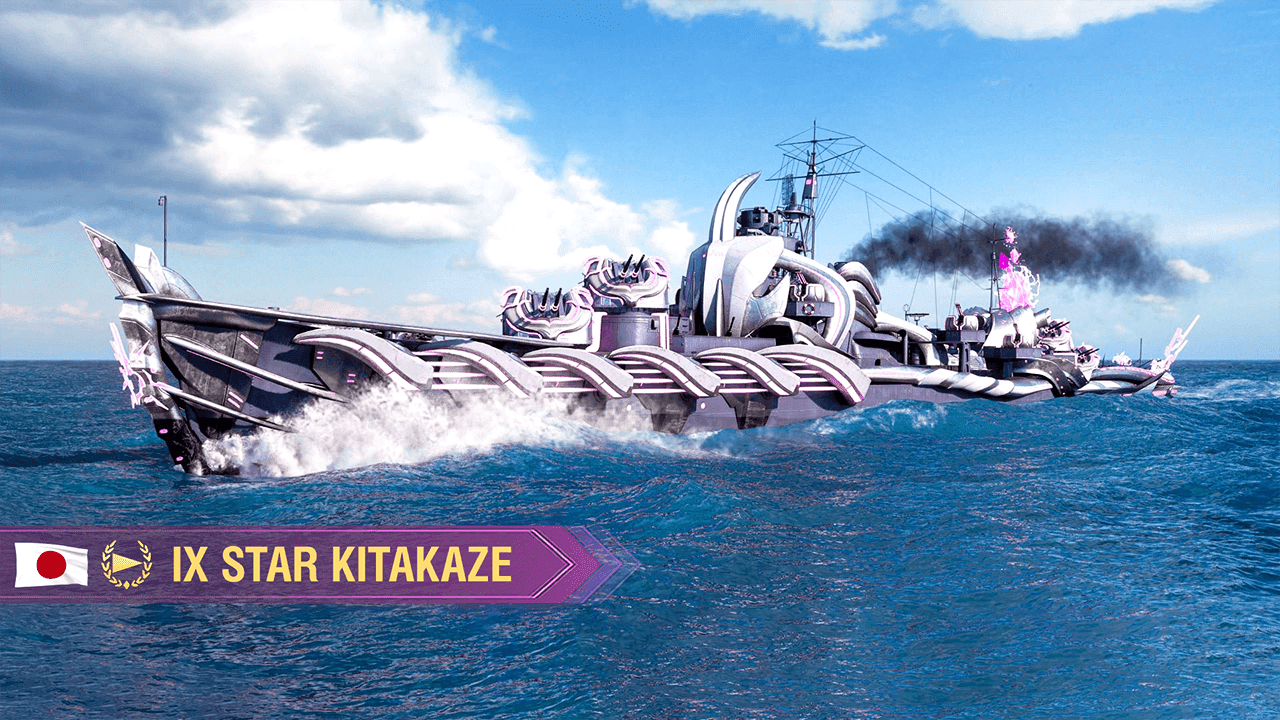
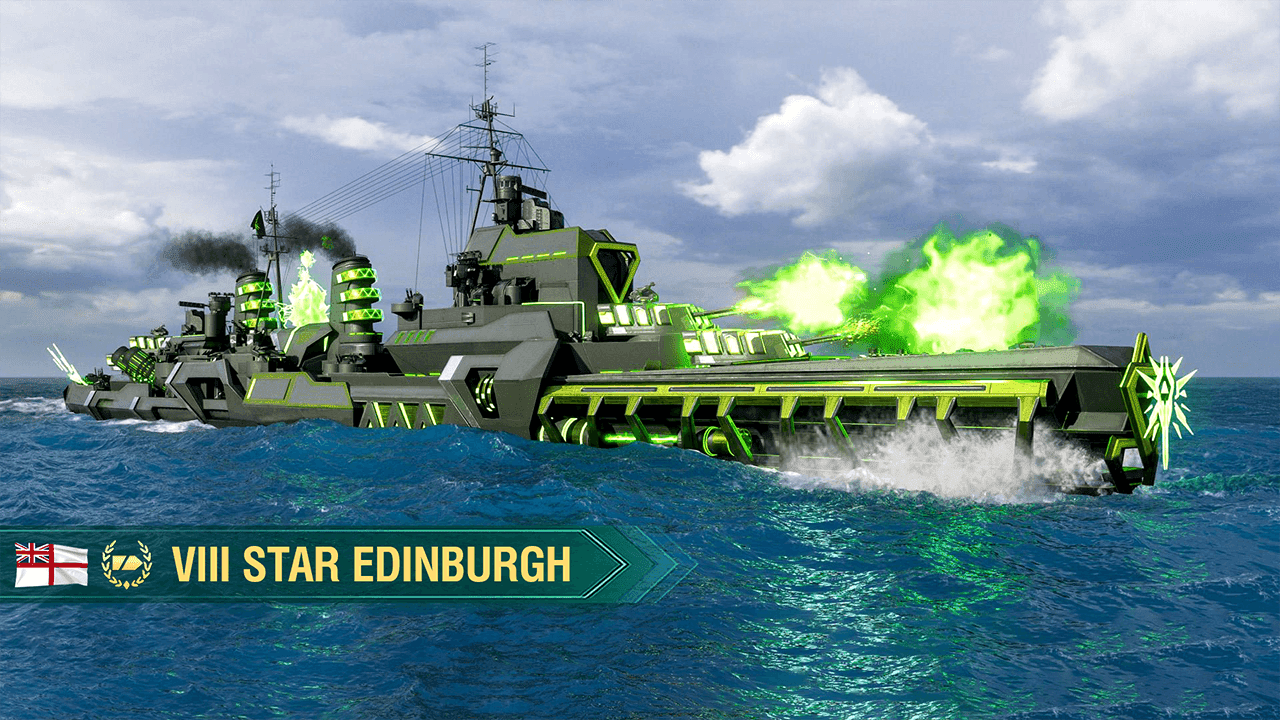
Wargaming, haciendo caja.
3 -
Por si alguien piensa que esto es una broma del 1 de abril, el barco es auténtico...


Que igual sí que es una broma el que lo metan en el juego...
 1
1 -
hace 18 minutos, alquimista112 dijo:2022 Guerra de Corea.
Vaya escenas aéreas. La gran mayoría de ellas, con aviones reales, incluido un Mig-15...
 1
1 -
hace 38 minutos, Jesús dijo:Prime Gaming regala el Wyoming con capitán y 1750 doblones ¡¡¡¡¡¡¡¡¡¡
Más 737.500 créditos y un espacio en el puerto al vender un barco inútil.
 5
5 -
hace 5 horas, judosaec dijo:Tienes toda la razón. He estado visionando el dvd de Tora Tora Tora y el despegue para el ataque y en las imagenes se ve que el despegue es hacia proa (como es lo normal) y la isla queda a estribor y no es real ya que el Akagi y el Hiryu son los dos únicos Poraviones que tuvierón el puente de mando (isla) a babor.
En las diferentes maquetas del Akagi que salen en la película, todas salen a estribor. Meeeek..., fallo.
Saludos, Julio.
Hombre, cabe la posibilidad que las fotos estén mal nombradas y que sea en realidad el Kaga...
0 -
Y el set de rodaje del Akagi:
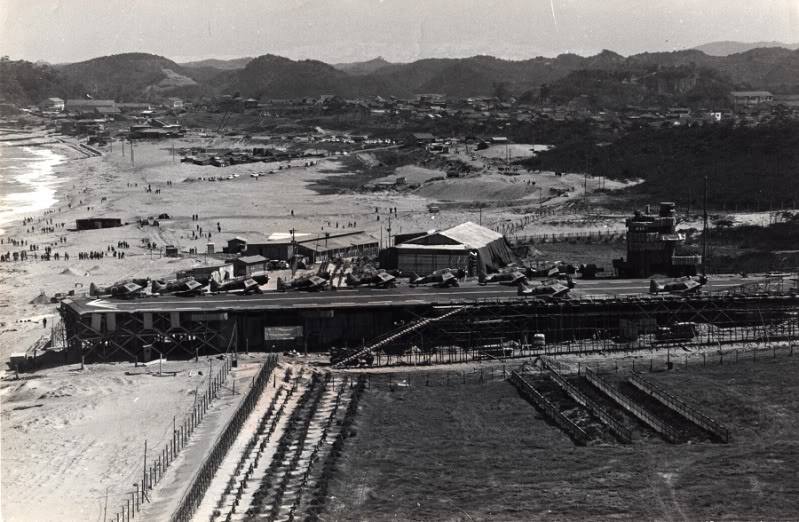
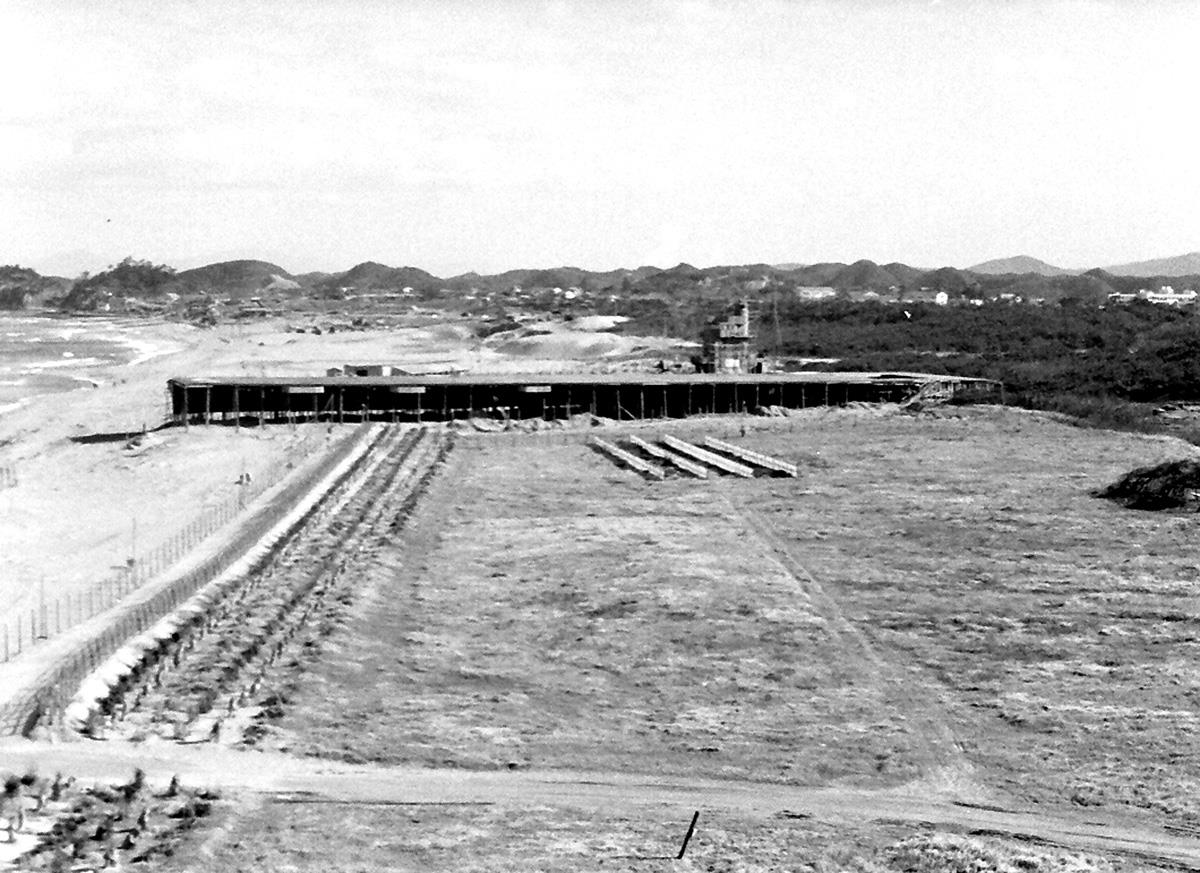
 hace 10 horas, judosaec dijo:
hace 10 horas, judosaec dijo:Los despegues al amanecer están hechos en un portaviones por la popa para imitar el puente de mando a babor del Akagi.
Si te refieres a esta escena, es de Pearl Harbor, no de Tora! Tora! Tora!
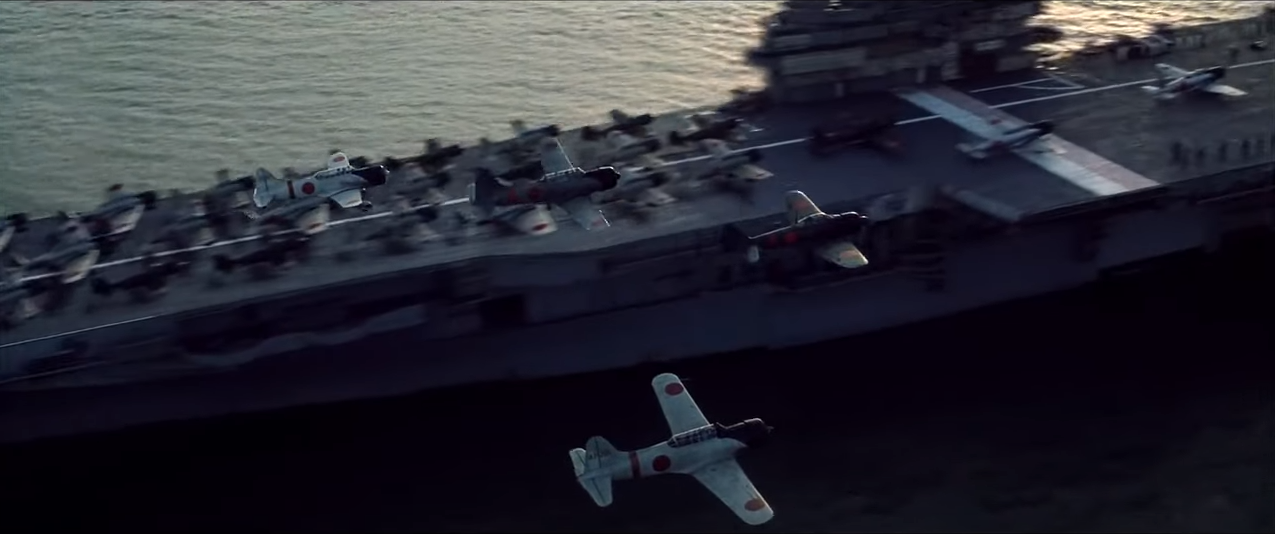 2
2 -
¿Cinco ya? Cómo pasa el tiempo...

¡¡Muchas felicidades!!
 0
0 -
hace 3 horas, Criseox dijo:El problema en el diseño que propone es que un acorazado necesita calibres altos para poder ser llamado acorazado y cumplir sus funciones, esos cañones grandes suponen una plataforma artillera estable lo que conlleva mucha manga (anchura) y coeficientes de bloque elevados.
No olvidemos que la tecnología de cañones de riel ya está en desarrollo, y que podrían ser una buena plataforma para este tipo de armas.
1 -
Ya que parece, por el calibre de la artillería principal, que el crucero de tier X español puede tener todas las papeletas de ser algún tipo de Napoli, y viendo también por el Álvaro de Bazán que la antiaérea de los tier altos españoles puede ir en la línea de ser la alemana de última generación, he hecho una modificación del Vizcaya para adaptarlo a estas posibilidades.
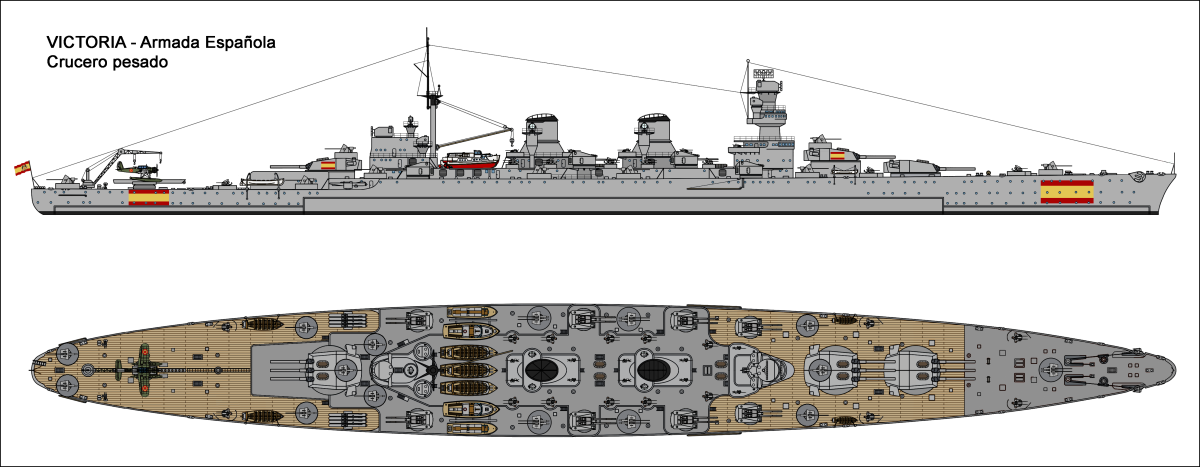
Armamento:
Artillería principal: 3x3 de 254 mm/60
Artillería secundaria: 8x2 KM40 de 128 mm /61 de doble propósito
Artillería antiaérea:
5x2 y 8x1 Gerät 58 de 55 mm/77
8x4, 8x2 y 10x1 Flak 103/38 de 30 mm/45Lanzatorpedos: 2x4 de 533 mm, con torpedos G7a
Antisubmarino: 1 varadero y 2 morteros lanzacargas de profundidad
Grupo aéreo: 4 Arado Ar 196, una catapulta.
En el equipo de la Bola de Cristal hemos decidido bautizar a este nuevo buque con el nombre de Victoria, en honor a la nao con la Elcano efectuó la primera vuelta al mundo. La Armada tiene en servicio actualmente una fragata de la clase Santa María con el mismo nombre, la F-82 Victoria.
 4
4 -
1 hour ago, Merkava_mkcuatro dijo:Buenas a todos de nuevo.
Os pido ayuda una vez más
 , ¿como se sale uno de un Clan (parte esencial para poder solicitar el ingreso en otro, cosa que por cierto tampoco sé como se hace
, ¿como se sale uno de un Clan (parte esencial para poder solicitar el ingreso en otro, cosa que por cierto tampoco sé como se hace  )
)
Gracias!
Saludos
En el Puerto, ve a Clan, pinchas en el nombre y aparecerá un menú de opciones con la de "Abandonar clan".
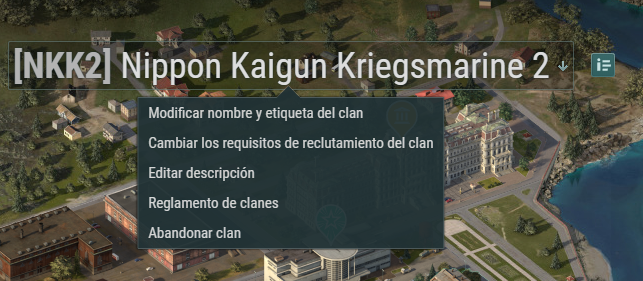 0
0 -
hace 35 minutos, DrWhat dijo:Que tenga que venir el del NKK a decir que también en el 1... TELA, ni que fuéramos clanes rivales


Joder... El Doc es que no perdona ni una...

Pues eso, que los del NKK3 que aspiren al gran salto, ahí está la diosa suprema Yamato con su NKK
 2
2 -
Pues parece que está todo aclarado y el cambio de nombre está justificado. Supongo que debido a circunstancias que no vienen al caso, DuainHicks no ha podido notificar el renombramiento, y es lo que ha echo saltar las alarmas.
Desde aquí deseo al nuevo clan una feliz singladura por esos mares que nos brinda WG.

También aprovecho para indicar, tal como ha hecho @FrankvC, que si algún miembro del antiguo NKK3 desea seguir dentro de la familia Nippon Kaigun Kriegsmarine, no dude en enviar una solicitud para el NKK2. Nuestra diosa Bismarck estará encantada de acoger a los fieles seguidores de Musashi
 1
1 -
hace 20 minutos, Merkava_mkcuatro dijo:Manolojones sabes quién fué el fundador del Clan? Es que no lo recuerdo
El mismo que el NKK y el NNK2: @Apxolius
hace 42 minutos, Merkava_mkcuatro dijo:No sé quién paga Manolojones pero.....no estoy muy contento con la maniobra. Creo que si el comandante quería montar un clan no tenía más que salirse de NKK3 y montar el suyo con todo lo que ello requiera.
Exacto.
hace 42 minutos, Merkava_mkcuatro dijo:Por ese motivo pido que por favor, con diligencia se me restituya como miembro del Clan NKK3 a la máxima brevedad posible.
Espera un poco a a ver si podemos contactar con @DuainHicks. Igual hay una explicación y vuelve a poner el nombre como estaba.
0 -
Primera noticia...

El comandante del NKK3 es @DuainHicks. Me temo que eso lo explica todo...
Ha cambiado el nombre sin consultar y sin tener en cuenta que él no ha pagado los 2.500 doblones que costó abrir ese clan.
1 -
Bueno, pero la primera rama, más que europea propiamente dicha, es casi totalmente sueca...
 0
0 -
Lástima de avión... Varios de los que pertenecieron al Ejército del Aire se vendieron para uso civil, pero nunca llegaron a volar y ahora están pudriéndose en Cuatro Vientos. Se me cae el alma al suelo cada vez que paso junto a ellos...
 2
2

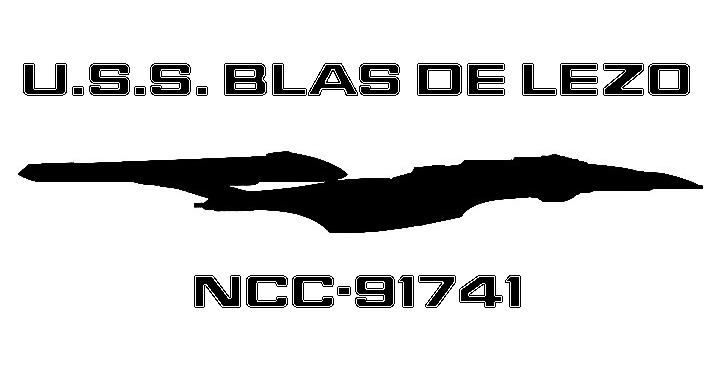

en Cruceros - CL/CA
Publicado
¿Como éste?